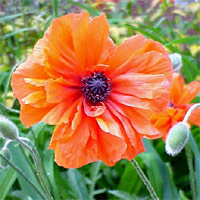Oriental Poppy

Sporting huge, cup-shaped blooms in early summer, the Oriental poppy is the most striking of the perennial poppies, and the delicate, papery flowers belie the plant's hardiness and durability.
About This Plant
A favorite subject for artists, Oriental poppy flowers are the focal point in the garden when they are in full bloom in late spring to early summer. The plant's huge flowers may be up to 6 inches across on stems up to 4 feet tall. Colors include red, salmon, orange, crimson, and white. Oriental poppies perform poorly in regions with hot summers, and the flowers may need staking to keep from flopping over when in full bloom. The plants go dormant after blooming.
Special Features
Easy care/low maintenance
Deer resistant
Planting Instructions
Plant in spring, spacing plants 2 to 3 feet apart, depending on the variety. Prepare the garden bed by using a garden fork or tiller to loosen the soil to a depth of 12 to 15 inches, then mix in a 2- to 4-inch layer of compost. Dig a hole twice the diameter of the pot the plant is in. Carefully remove the plant from its container and place it in the hole so the top of the root ball is level with the soil surface. Carefully fill in around the root ball and firm the soil gently. Water thoroughly.
Care
Apply a thin layer of compost each spring, followed by a 2-inch layer of mulch to retain moisture and control weeds. During the summer months, when plants are dormant, watering is needed only during periods of drought. In autumn, poppies will resume foliage growth until frost, and these green leaves will remain over winter. After soil has frozen, apply a 4- to 6-inch layer of protective mulch to prevent heaving during periods of temperature fluctuation. When the weather warms up in spring, gradually remove the winter mulch. Plants can be divided in early spring or summer.






 Sporting huge, cup-shaped blooms in early summer, the Oriental poppy is the most striking of the perennial poppies, and the delicate, papery flowers belie the plant's hardiness and durability.
Sporting huge, cup-shaped blooms in early summer, the Oriental poppy is the most striking of the perennial poppies, and the delicate, papery flowers belie the plant's hardiness and durability.